Hallo!
Since I had taken a look at the Colt M1860 Army, I thought a Quick Look at the Colt Model 1851 (Old Model) Navy and M1861 (New Model) Navy revolvers.
As is sometimes the case, and often the irony of history, reenacting, and collecting that guns suffer from “inaccurate” year designations. Two popular ones, the Colt Model 1849 Pocket and the Model 1851 Navy revolver did not come out in those years, but rather in 1850 about the same time.
Colt had learned some lessons from the failure of his .36 Paterson revolver, and in 1847 conceived the two new revolvers. Eventually, somewhere over a hundred distinct variations would be turned out by Hartford and London. It was clever marketing, as Colt now could offer customers choices in .31, .36, and .44 caliber handguns in pocket, belt, and holster revolvers.
Some historians hold that Colt introduced the term “Navy Model” with the intent that his .44 Dragoon Model would appeal and sell to the Army, while the .36 would go to the sea for the Navy.
However, most of the M1851’s sold to the Government were set for military use and not just naval use.
While there were over a hundred variations on the theme, not counting custom orders, and exact numbers are unknown or complicated due to evolutions made on early versions, Colt M1851 Navy’s Fall into a modern typology of four models.
Texas held some sentiment for Samuel Colt possibly due to his business getting started there with the Walker Dragoon. Plus the interest by Commodore Edwin Moore, commander in chief of the Texas Navy. The cylinder was roll engraved and marked with the date May 16, 1843, who bought some revolvers and carbines and saved Colt from the absolute bottom.
The “naval scene” was the battle of Campeche at which Mexico including two British built and officered ironclad steamships was defeated by the Texas Navy after an earlier draw in April. Many consider the second engagement a draw, but the Mexicans suffered higher casualties. It is a rare example of sailing ships defeating steam ships.
Having sailed without orders and against Texas President Sam Houston’s wishes, Houston was furious and tried to get Moore and his crews for piracy. Eventually the Texas Navy was shut down.
M1851 cylinders were roll engraved and marked with the date May 16, 1843. The same scene would be repeated on the M1860 Type III and IV Army revolvers, as well as on the M1861 Navy revolver.
Type I. (First Model Squareback)

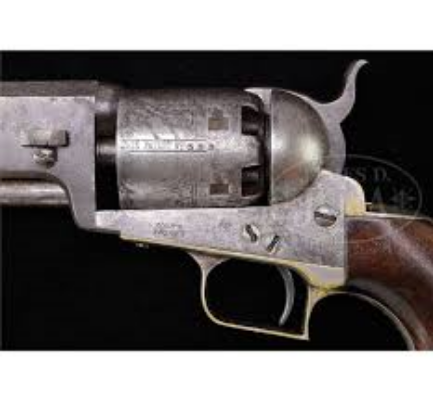
The majority of about 850 1st Model M1851’s were made mostly from mid-1850 through 1851 and represent about 20% of all of the so--called “square back Navy’s.’ for the squared backside of the trigger guard.
The Government was somewhat slow to take notice or be interested. In June 1852 100 Navy’s and Pockets were purchased by the Navy Department as part of Commodore Perry’s expedition to the East Indies and Chinese Seas (Japan). Colt was then notified that Perry wanted the following breakdown:
25 Colt Dragoons
50 Navy pistols
6 four and five inch barreled (M1849) Pockets
13 six inch barreled Pockets.
The 50 M1851’s were believed to have been Types I and II’s. (Colt’s selling price $24.00.)
Type II. (Second Model Squareback)
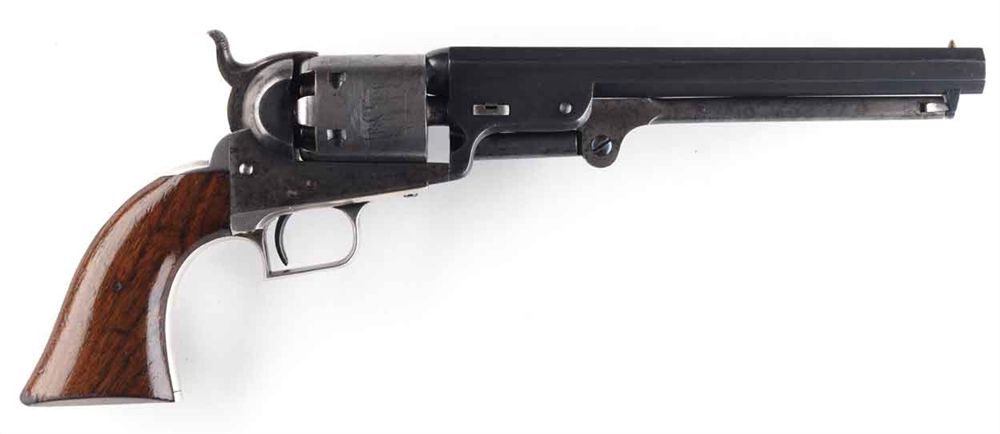
Complaints about the cylinder arbor and barrel wedge or key configuration saw a change into the
Type II. The Type I had a cylinder arbor or shaft with a half a slot on the top held in place by a wedge with the screw below it. For the Type II.
Production of the 2nd Model was limited to 1851.
Type III. (small round trigger guard)
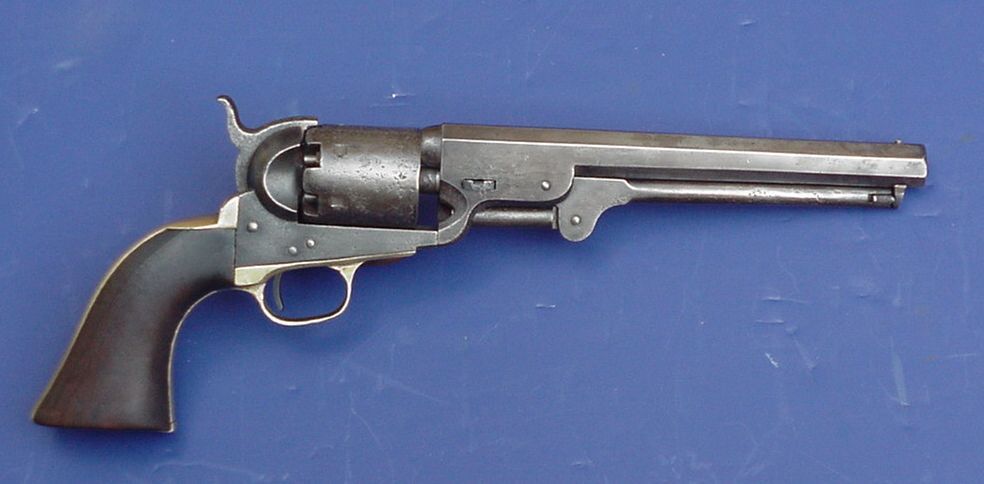

Pre War Ordnance Department purchases of Colt revolvers would surprisingly be focused on the new M1851 Navy Revolver (AKA “Belt Pistol”’). This was partially due to the cavalry rethinking of the mid 1850’s, especially when the new 1st and 2nd Cavalry Regiments were created in March of 1855.
With one exception of 316 Dragoon pistols in June of 1856, from May of 1855 through January 1859 Colt Navy’s made up the contracts and purchases of Colt revolvers. Initially the Army was interested only in .44 Dragoon pistols, but in January 1855 the order for 1,000 holster pistols was changed to read belt pistols. Between May 1855 and November 1859, 18,252 revolvers were delivered by Colt with 16,962 being M1851 Navy’s and the rest 3rd Model Dragoons.
It can be confusing, but purchases of Colt M1851 Navy’s were made through three methods. A larger contract basis on the part of the Ordnance Department for the Army and the Navy, contracts granted directly by the Department of Navy, and open market purchases by both the Ordnance Department and the Navy. (The Navy seemed to have liked open market purchases over contracts as they contracted for just under 3,000, but bought almost 12,000 Navy’s on the open market).
The majority of pre War Colt Navy’s were the Type III.
As part of the thinking of the time, a “4 Screw” version with a milled recoil shield was introduced for use with a shoulder stock. Some include a sling swivel loop in front of the trigger guard.
Type IV. (large round trigger guard)
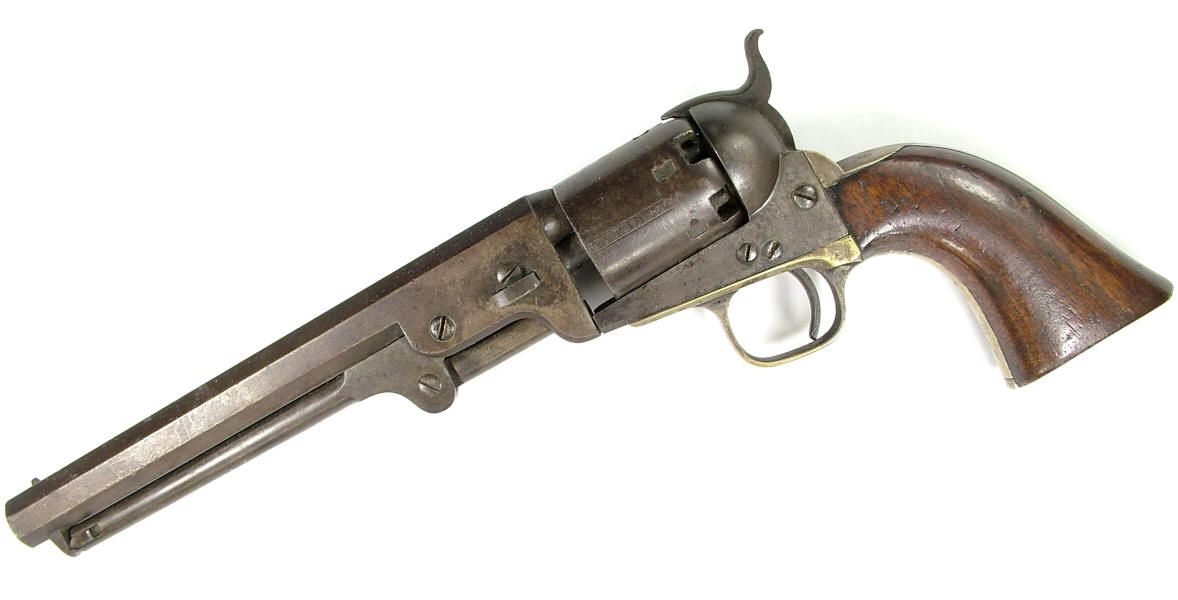
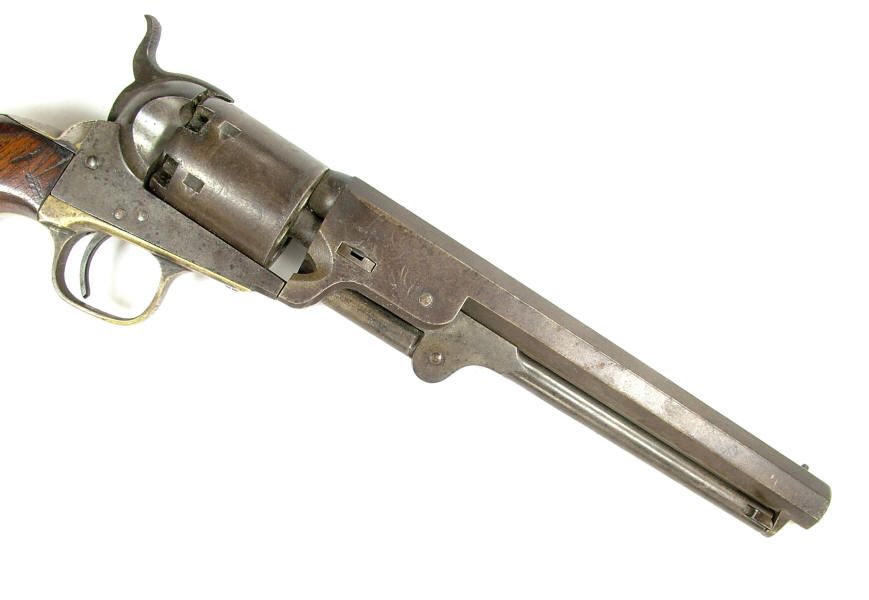
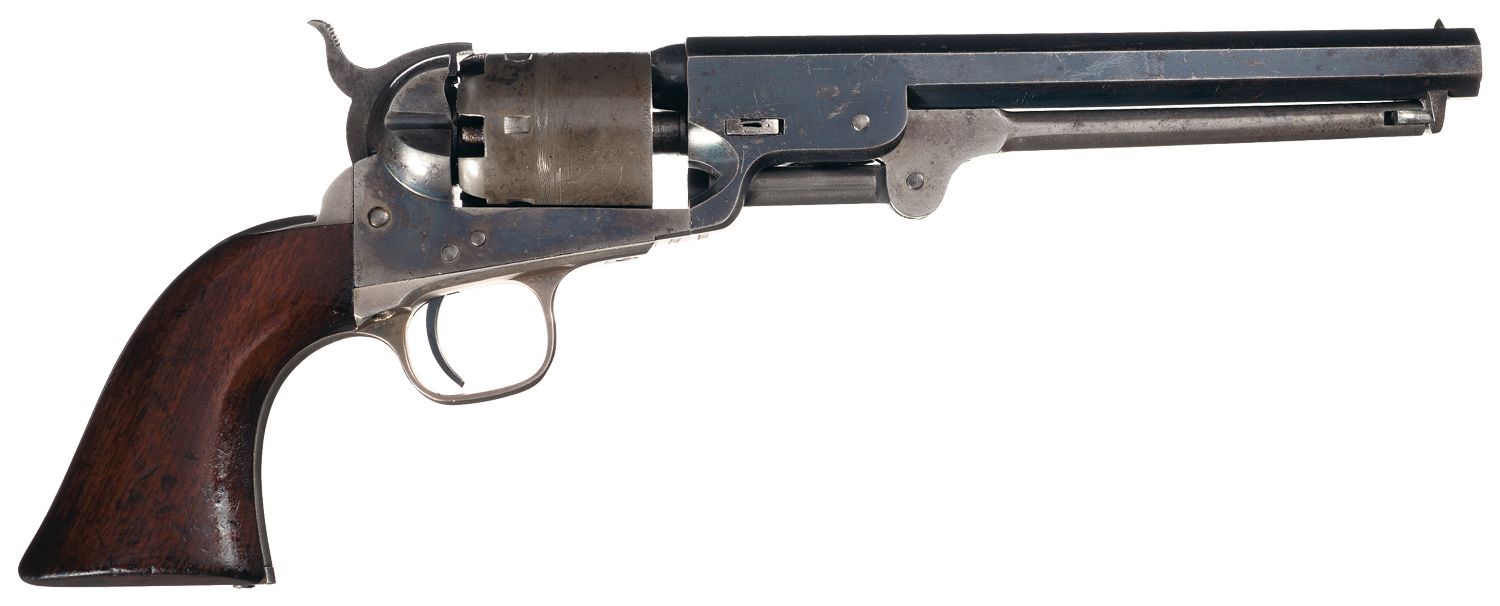
As was typical for Colt, firearms evolved as new features saw their parts gradually introduced while existing inventories of the older model parts were still being used. So, the last variation, the Type IV started to have features appear as early as January 1858 it would be January of 1859 before the shift from Type III to Type IV was complete (but not 100% gone for a short time).
In addition to the brass grip frame, a large brass oval or round trigger guard, the Type IV added a capping groove in the recoil shield, found in two sizes.
One of the many slight variations is the batch of Type IV’s Colt delivered to the Boston Navy Yard in September of 1859 have London features such as iron grip frame. After roughly three years of boom, the London factory closed In December 1856 when the Crimean War sales boom to the British was over, and with a decision not to make Colt revolvers the new sidearm for the British military, Colt could sustain the operation. . An additional 42,000 M1851’s were made in London, England.
215,348 Colt M1851 Navy’s made by Colt at Hartford between 1850 and 1873, a possible 125,000 were Type IV’s. An additional 42,000 were made in London, England.
The Model 1861 Navy (which became the New Model Navy and made the M1851 the Old Model Navy Revolver.).
Colt had run into trouble with Secretary of War Stanton and the Ordnance Department in 1862 over the high prices of his Army and Navy revolvers and their unwillingness to be competitive. This would lead to a shift by the Government away from Colt and towards cheaper priced competition such as Remington. As Colt contracts ran out, they were not renewed. The new contract for Navy revolvers would be a new and improved Navy revolver that was more streamlined known as the Model 1861, the New Model Navy, (aka the streamlined Navy, or the round barreled Navy revolver).
The Navy was interested, and placed a series of orders starting in October 1861 for 2,578 at $23.00 each.
The Army ordered its only batch of 1,000 in February 1862.
The Ordnance Department purchased 2,707 more in May of 1862 at Colt’s $25.00.
Colt thought they were doing well, as throughout the 1850’s their M1851 cost $24.00 dropped to $18.00 in 1857. Plus anticipating a war, Colt had ramped up production capabilities that would eventually lead in 1862 to 24 hour operations. And then with War time “inflation, saw the price of the new M1861 Navy go to $23.00. In February 1862, Colt got a little worried and offered a price of $22.50 versus the $25.00 for the M1860 Army. $22.50 was Colt’s stock price, which was the same he asked for from individual states buying them such as Illinois, Connecticut, and Ohio. But less than the $23.00 for the Department of the Navy.
Perhaps finally, but not fully realizing they had fallen from favor, Colt dropped the price to the Navy from $23.00 down to $15.00 in June of 1862. But it was too late. He would get no new contracts for 1863 on. Remington was selling their Navy’s at $12.00 and Whitney was also selling a barely legal clone of the Remington Navy for $12.00.
Colt would continue making M1861 Navy’s even though the Government was not interested. And even with the February 1864 that destroyed the factory Colt was able to bounce back with parts and then rebuilt, making 38,843 M1861’s by 1873.
Sometimes using “typology” for classifying, understanding, and being to conveniently speak about guns is useful. Sometimes not so much.
The M1861 Navy mirrored some of the evolutions or variation on the M1860 Army.
IMHO, the Colt M1861 Navy revolver is one example. “Variations” or “types? IMHO, there should be four “types:”
1. Type I. First 30 made with a double fluted cylinder and that lacked the capping grove on the recoil shield.
2. Type II. At about 50, a capping groove was added.
3. Type III. About 100 were made as a “4 Screw” version with milled recoil shield and the fourth screw/stud for a dragoon style shoulder stock featuring the internal canteen.
4. Type IV. Capping groove and a round cylinder.
As can often be the case, the Colt M1861 can fall victim to reenactorisms and the suppliers that serve those interests or market.
The most commonly found reproduction of the M1861 is the extremely rare “Type III.” Some refer to this as the “military version.”

The next most common is the most Period common and made up the vast majority of the original M1861 Navy’s made, and that is the “Type IV.” (Referred to by some as the “civilian” version.
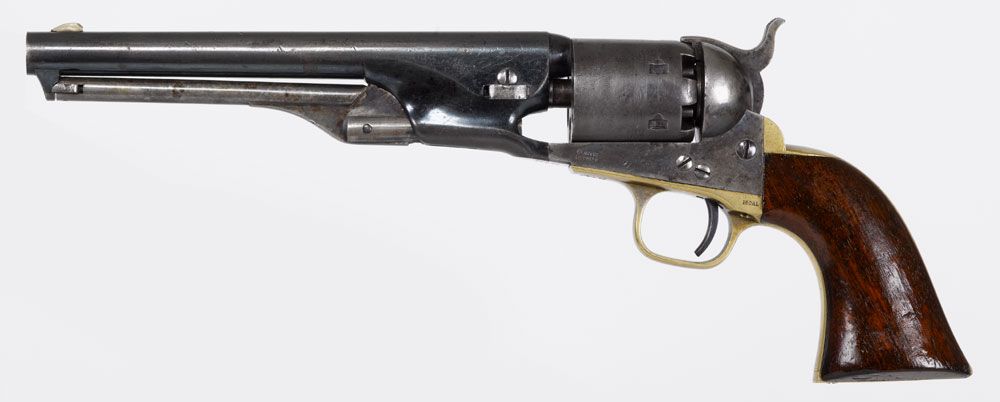
Sometimes the .36 Colt M1861 Navy is believed to be, and gets described as also being in .44 calibre. This is due to its looking like the M1860 Army in general, and in particular because size and scale can be hard to determine in photographs. Plus every once in a while a rare 7 ½ barreled M1860 pops up giving the illusion it is a .44 Navy.

Uberti makes the “best” Colt M1861 Navy reproduction (all things “Italian” considered).
One can still find “Colt” 2nd Generation versions made in 1980 and 1981. However, they are not military M1861’s but rather factory special or “civilian” versions and have silver plated grip frames/back straps. 3rd Generations aka “Late Third Generation” aka “4th Generation,” aka “Blackpowder Signature Series” made circa 1995 are also a very rare variation with iron/steel grip frames/back strap and trigger guards.
There is controversy over 2nd and 3rd Generation Colt “Colts.” Second generation Colt revolvers were assembled in New Jersey using Uberti parts by Iver Johnson. Third generation Colt Signature Series revolvers were assembled in Brooklyn, NY, using Uberti parts, by Colt Blackpowder Arms Company. Both Iver Johnson and Colt Blackpowder Arms Company were owned by Louis Imperato. Iver Johnson was sold by Imperato just before the introduction of the Colt Signature Series.
Both 2nd and 3rd Generation Colt blackpowder revolvers were made under license from Colt. That included, allegedly, using Colt standards for fit, function, finish, and quality control. However, in my experience in handling them, 2nd Generation NUG are superior to 3rd Generations in that regard- and some 3rd Generations seem to have an “Italian’ quality or lack of quality about them.
Colt 3rd Generation/Blackpowder Signature Series” are challenged for being a more authentic choice as while they carry Colt markings, they also carry the distinctive bust and signature of Samuel Colt on the trigger guard bow. This requires extra work in polishing off if one weighs authenticity over resale value.
Next in the pecking order comes the Uberti offerings.
And last are the mixed quality. randomish QC, EMF and Pietta M1861’s. While few may would see the problem with the grip frame profile or shape, Pietta uses an eight (8) inch barrel (M1860 Army) rather than the M1861’s 7 ½ which is noticeable as it sticks out beyond the loading lever catch more than it should. Pietta’s may also have an incorrect rebated cylinder as well.
The Colt M1860 Army, M1861 Navy. And M1862 Pocket and M1862 Police were the peak of Colt’s black powder era lasting into the early 1870’s. But with only less than 4,000 purchased by the government (of which 650 were by the Navy) and a handful more by individual states during the War, it is not perhaps the best choice for a common sidearm unless issued to the unit one is portraying.
Curt
Since I had taken a look at the Colt M1860 Army, I thought a Quick Look at the Colt Model 1851 (Old Model) Navy and M1861 (New Model) Navy revolvers.
As is sometimes the case, and often the irony of history, reenacting, and collecting that guns suffer from “inaccurate” year designations. Two popular ones, the Colt Model 1849 Pocket and the Model 1851 Navy revolver did not come out in those years, but rather in 1850 about the same time.
Colt had learned some lessons from the failure of his .36 Paterson revolver, and in 1847 conceived the two new revolvers. Eventually, somewhere over a hundred distinct variations would be turned out by Hartford and London. It was clever marketing, as Colt now could offer customers choices in .31, .36, and .44 caliber handguns in pocket, belt, and holster revolvers.
Some historians hold that Colt introduced the term “Navy Model” with the intent that his .44 Dragoon Model would appeal and sell to the Army, while the .36 would go to the sea for the Navy.
However, most of the M1851’s sold to the Government were set for military use and not just naval use.
While there were over a hundred variations on the theme, not counting custom orders, and exact numbers are unknown or complicated due to evolutions made on early versions, Colt M1851 Navy’s Fall into a modern typology of four models.
Texas held some sentiment for Samuel Colt possibly due to his business getting started there with the Walker Dragoon. Plus the interest by Commodore Edwin Moore, commander in chief of the Texas Navy. The cylinder was roll engraved and marked with the date May 16, 1843, who bought some revolvers and carbines and saved Colt from the absolute bottom.
The “naval scene” was the battle of Campeche at which Mexico including two British built and officered ironclad steamships was defeated by the Texas Navy after an earlier draw in April. Many consider the second engagement a draw, but the Mexicans suffered higher casualties. It is a rare example of sailing ships defeating steam ships.
Having sailed without orders and against Texas President Sam Houston’s wishes, Houston was furious and tried to get Moore and his crews for piracy. Eventually the Texas Navy was shut down.
M1851 cylinders were roll engraved and marked with the date May 16, 1843. The same scene would be repeated on the M1860 Type III and IV Army revolvers, as well as on the M1861 Navy revolver.
Type I. (First Model Squareback)


The majority of about 850 1st Model M1851’s were made mostly from mid-1850 through 1851 and represent about 20% of all of the so--called “square back Navy’s.’ for the squared backside of the trigger guard.
The Government was somewhat slow to take notice or be interested. In June 1852 100 Navy’s and Pockets were purchased by the Navy Department as part of Commodore Perry’s expedition to the East Indies and Chinese Seas (Japan). Colt was then notified that Perry wanted the following breakdown:
25 Colt Dragoons
50 Navy pistols
6 four and five inch barreled (M1849) Pockets
13 six inch barreled Pockets.
The 50 M1851’s were believed to have been Types I and II’s. (Colt’s selling price $24.00.)
Type II. (Second Model Squareback)

Complaints about the cylinder arbor and barrel wedge or key configuration saw a change into the
Type II. The Type I had a cylinder arbor or shaft with a half a slot on the top held in place by a wedge with the screw below it. For the Type II.
Production of the 2nd Model was limited to 1851.
Type III. (small round trigger guard)


Pre War Ordnance Department purchases of Colt revolvers would surprisingly be focused on the new M1851 Navy Revolver (AKA “Belt Pistol”’). This was partially due to the cavalry rethinking of the mid 1850’s, especially when the new 1st and 2nd Cavalry Regiments were created in March of 1855.
With one exception of 316 Dragoon pistols in June of 1856, from May of 1855 through January 1859 Colt Navy’s made up the contracts and purchases of Colt revolvers. Initially the Army was interested only in .44 Dragoon pistols, but in January 1855 the order for 1,000 holster pistols was changed to read belt pistols. Between May 1855 and November 1859, 18,252 revolvers were delivered by Colt with 16,962 being M1851 Navy’s and the rest 3rd Model Dragoons.
It can be confusing, but purchases of Colt M1851 Navy’s were made through three methods. A larger contract basis on the part of the Ordnance Department for the Army and the Navy, contracts granted directly by the Department of Navy, and open market purchases by both the Ordnance Department and the Navy. (The Navy seemed to have liked open market purchases over contracts as they contracted for just under 3,000, but bought almost 12,000 Navy’s on the open market).
The majority of pre War Colt Navy’s were the Type III.
As part of the thinking of the time, a “4 Screw” version with a milled recoil shield was introduced for use with a shoulder stock. Some include a sling swivel loop in front of the trigger guard.
Type IV. (large round trigger guard)



As was typical for Colt, firearms evolved as new features saw their parts gradually introduced while existing inventories of the older model parts were still being used. So, the last variation, the Type IV started to have features appear as early as January 1858 it would be January of 1859 before the shift from Type III to Type IV was complete (but not 100% gone for a short time).
In addition to the brass grip frame, a large brass oval or round trigger guard, the Type IV added a capping groove in the recoil shield, found in two sizes.
One of the many slight variations is the batch of Type IV’s Colt delivered to the Boston Navy Yard in September of 1859 have London features such as iron grip frame. After roughly three years of boom, the London factory closed In December 1856 when the Crimean War sales boom to the British was over, and with a decision not to make Colt revolvers the new sidearm for the British military, Colt could sustain the operation. . An additional 42,000 M1851’s were made in London, England.
215,348 Colt M1851 Navy’s made by Colt at Hartford between 1850 and 1873, a possible 125,000 were Type IV’s. An additional 42,000 were made in London, England.
The Model 1861 Navy (which became the New Model Navy and made the M1851 the Old Model Navy Revolver.).
Colt had run into trouble with Secretary of War Stanton and the Ordnance Department in 1862 over the high prices of his Army and Navy revolvers and their unwillingness to be competitive. This would lead to a shift by the Government away from Colt and towards cheaper priced competition such as Remington. As Colt contracts ran out, they were not renewed. The new contract for Navy revolvers would be a new and improved Navy revolver that was more streamlined known as the Model 1861, the New Model Navy, (aka the streamlined Navy, or the round barreled Navy revolver).
The Navy was interested, and placed a series of orders starting in October 1861 for 2,578 at $23.00 each.
The Army ordered its only batch of 1,000 in February 1862.
The Ordnance Department purchased 2,707 more in May of 1862 at Colt’s $25.00.
Colt thought they were doing well, as throughout the 1850’s their M1851 cost $24.00 dropped to $18.00 in 1857. Plus anticipating a war, Colt had ramped up production capabilities that would eventually lead in 1862 to 24 hour operations. And then with War time “inflation, saw the price of the new M1861 Navy go to $23.00. In February 1862, Colt got a little worried and offered a price of $22.50 versus the $25.00 for the M1860 Army. $22.50 was Colt’s stock price, which was the same he asked for from individual states buying them such as Illinois, Connecticut, and Ohio. But less than the $23.00 for the Department of the Navy.
Perhaps finally, but not fully realizing they had fallen from favor, Colt dropped the price to the Navy from $23.00 down to $15.00 in June of 1862. But it was too late. He would get no new contracts for 1863 on. Remington was selling their Navy’s at $12.00 and Whitney was also selling a barely legal clone of the Remington Navy for $12.00.
Colt would continue making M1861 Navy’s even though the Government was not interested. And even with the February 1864 that destroyed the factory Colt was able to bounce back with parts and then rebuilt, making 38,843 M1861’s by 1873.
Sometimes using “typology” for classifying, understanding, and being to conveniently speak about guns is useful. Sometimes not so much.
The M1861 Navy mirrored some of the evolutions or variation on the M1860 Army.
IMHO, the Colt M1861 Navy revolver is one example. “Variations” or “types? IMHO, there should be four “types:”
1. Type I. First 30 made with a double fluted cylinder and that lacked the capping grove on the recoil shield.
2. Type II. At about 50, a capping groove was added.
3. Type III. About 100 were made as a “4 Screw” version with milled recoil shield and the fourth screw/stud for a dragoon style shoulder stock featuring the internal canteen.
4. Type IV. Capping groove and a round cylinder.
As can often be the case, the Colt M1861 can fall victim to reenactorisms and the suppliers that serve those interests or market.
The most commonly found reproduction of the M1861 is the extremely rare “Type III.” Some refer to this as the “military version.”

The next most common is the most Period common and made up the vast majority of the original M1861 Navy’s made, and that is the “Type IV.” (Referred to by some as the “civilian” version.

Sometimes the .36 Colt M1861 Navy is believed to be, and gets described as also being in .44 calibre. This is due to its looking like the M1860 Army in general, and in particular because size and scale can be hard to determine in photographs. Plus every once in a while a rare 7 ½ barreled M1860 pops up giving the illusion it is a .44 Navy.

Uberti makes the “best” Colt M1861 Navy reproduction (all things “Italian” considered).
One can still find “Colt” 2nd Generation versions made in 1980 and 1981. However, they are not military M1861’s but rather factory special or “civilian” versions and have silver plated grip frames/back straps. 3rd Generations aka “Late Third Generation” aka “4th Generation,” aka “Blackpowder Signature Series” made circa 1995 are also a very rare variation with iron/steel grip frames/back strap and trigger guards.
There is controversy over 2nd and 3rd Generation Colt “Colts.” Second generation Colt revolvers were assembled in New Jersey using Uberti parts by Iver Johnson. Third generation Colt Signature Series revolvers were assembled in Brooklyn, NY, using Uberti parts, by Colt Blackpowder Arms Company. Both Iver Johnson and Colt Blackpowder Arms Company were owned by Louis Imperato. Iver Johnson was sold by Imperato just before the introduction of the Colt Signature Series.
Both 2nd and 3rd Generation Colt blackpowder revolvers were made under license from Colt. That included, allegedly, using Colt standards for fit, function, finish, and quality control. However, in my experience in handling them, 2nd Generation NUG are superior to 3rd Generations in that regard- and some 3rd Generations seem to have an “Italian’ quality or lack of quality about them.
Colt 3rd Generation/Blackpowder Signature Series” are challenged for being a more authentic choice as while they carry Colt markings, they also carry the distinctive bust and signature of Samuel Colt on the trigger guard bow. This requires extra work in polishing off if one weighs authenticity over resale value.
Next in the pecking order comes the Uberti offerings.
And last are the mixed quality. randomish QC, EMF and Pietta M1861’s. While few may would see the problem with the grip frame profile or shape, Pietta uses an eight (8) inch barrel (M1860 Army) rather than the M1861’s 7 ½ which is noticeable as it sticks out beyond the loading lever catch more than it should. Pietta’s may also have an incorrect rebated cylinder as well.
The Colt M1860 Army, M1861 Navy. And M1862 Pocket and M1862 Police were the peak of Colt’s black powder era lasting into the early 1870’s. But with only less than 4,000 purchased by the government (of which 650 were by the Navy) and a handful more by individual states during the War, it is not perhaps the best choice for a common sidearm unless issued to the unit one is portraying.
Curt





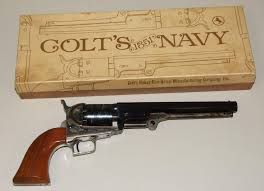
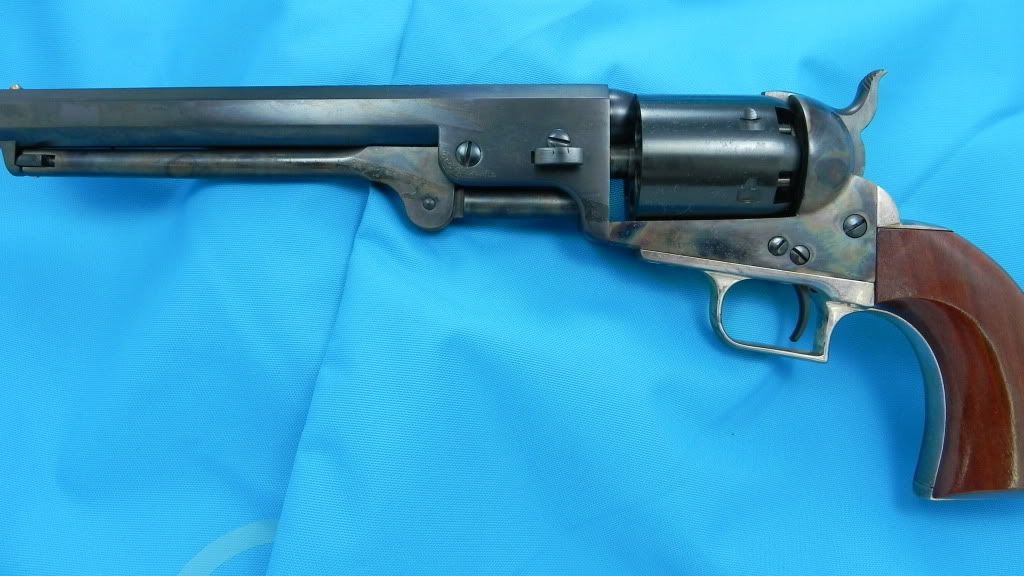
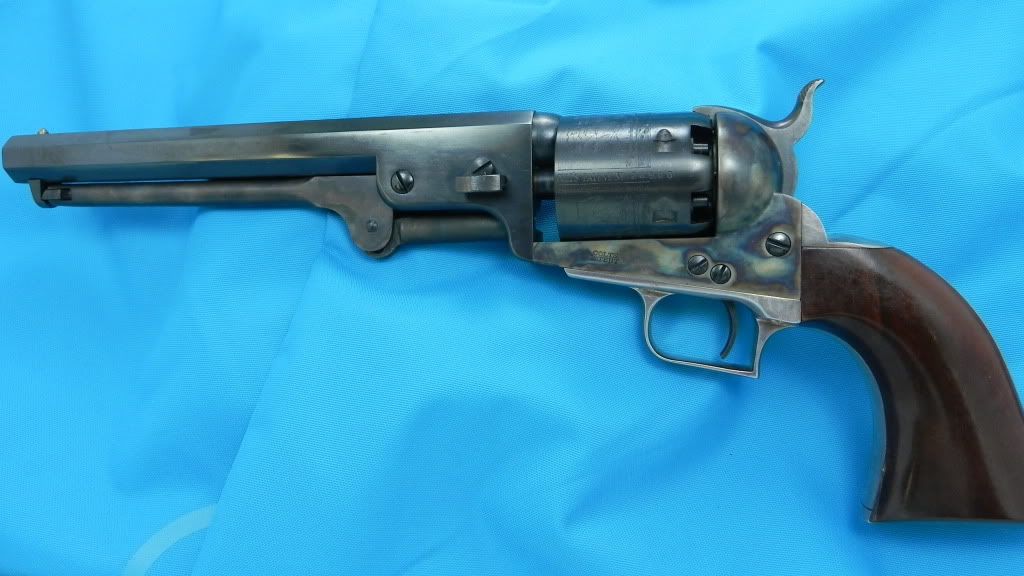
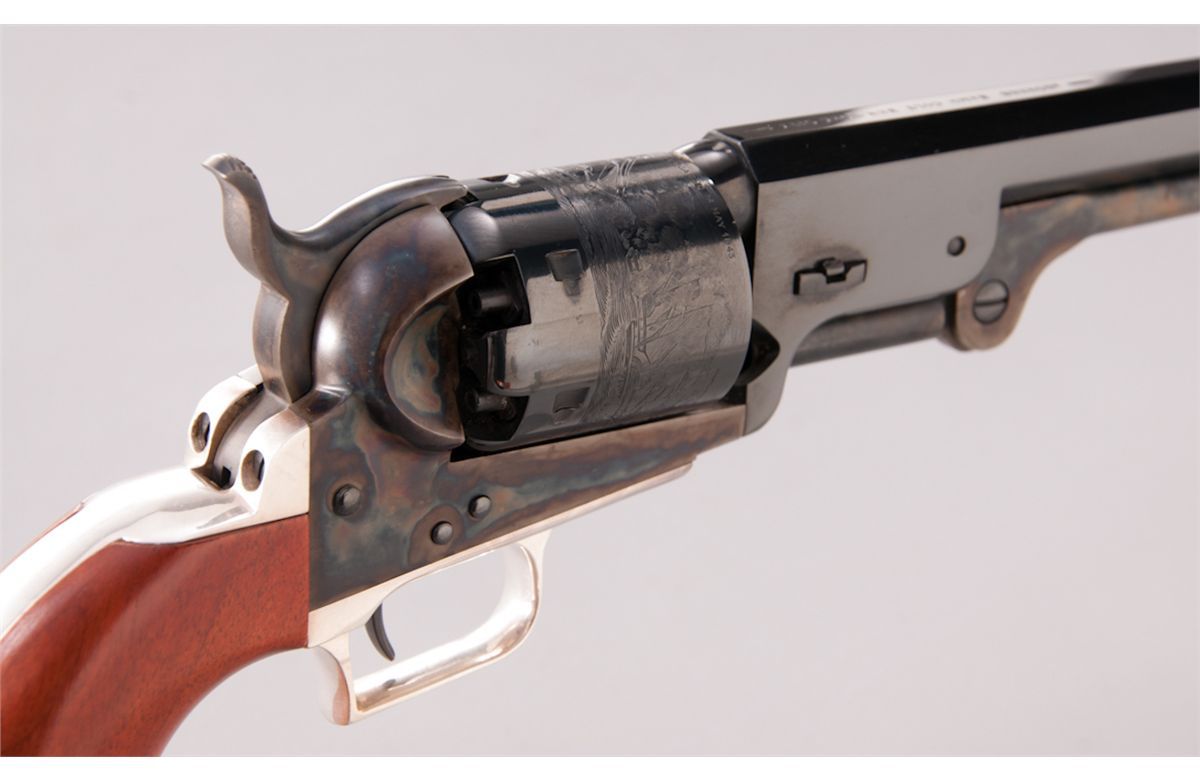



Comment